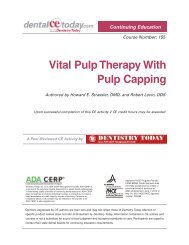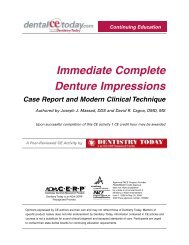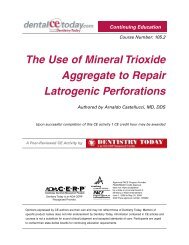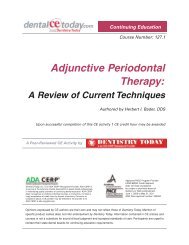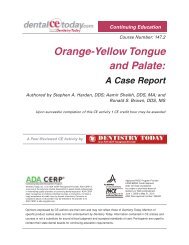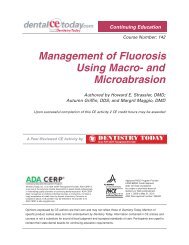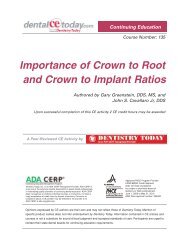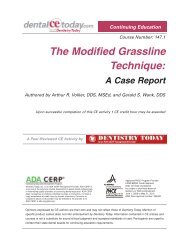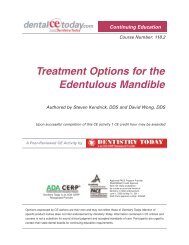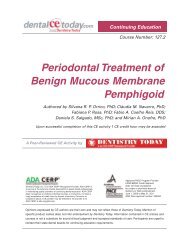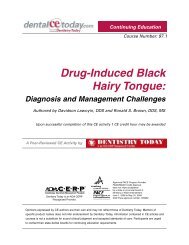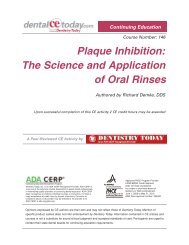Practical Periodontics: A Review of Core ... - DentalCEToday
Practical Periodontics: A Review of Core ... - DentalCEToday
Practical Periodontics: A Review of Core ... - DentalCEToday
You also want an ePaper? Increase the reach of your titles
YUMPU automatically turns print PDFs into web optimized ePapers that Google loves.
Continuing Education<br />
<strong>Practical</strong> <strong>Periodontics</strong><br />
A <strong>Review</strong> <strong>of</strong> <strong>Core</strong> Periodontal<br />
Treatment Principles<br />
Authored by Gary Greenstein, DDS, MS<br />
Upon successful completion <strong>of</strong> this CE activity 1 CE credit hour may be awarded<br />
A Peer-<strong>Review</strong>ed CE Activity by<br />
Dentistry Today is an ADA CERP<br />
Recognized Provider.<br />
Approved PACE Program Provider<br />
FAGD/MAGD Credit Approval<br />
does not imply acceptance<br />
by a state or provincial board <strong>of</strong><br />
dentistry or AGD endorsement.<br />
June 1, 2006 to May 31, 2009<br />
AGD Pace approval number: 309062<br />
Opinions expressed by CE authors are their own and may not reflect those <strong>of</strong> Dentistry Today. Mention <strong>of</strong><br />
specific product names does not infer endorsement by Dentistry Today. Information contained in CE articles and<br />
courses is not a substitute for sound clinical judgment and accepted standards <strong>of</strong> care. Participants are urged<br />
to contact their state dental boards for continuing education requirements.
<strong>Practical</strong> <strong>Periodontics</strong><br />
A <strong>Review</strong> <strong>of</strong> <strong>Core</strong> Periodontal<br />
Treatment Principles<br />
LEARNING OBJECTIVES:<br />
Continuing Education<br />
Recommendations for Fluoride Varnish Use in Caries Management<br />
• Granulomatous tissue is inflamed tissue that is debrided<br />
or removed. It is not proper to refer to it as granulation<br />
tissue, which is healing tissue.<br />
• Mucogingival flaps are <strong>of</strong>ten apically positioned during<br />
periodontal surgery, so it is redundant to call it an<br />
apically repositioned flap.<br />
• Infrabony defect is a generic term for a vertical defect.<br />
The word intrabony specifically denotes a 3-wall defect.<br />
After reading this article, the individual will learn:<br />
• core principles that result in a successful clinical<br />
practice, and<br />
• how to manage problems that arise when treating<br />
periodontal patients.<br />
ABOUT THE AUTHOR<br />
Dr. Greenstein is a clinical pr<strong>of</strong>essor,<br />
Department <strong>of</strong> Periodontology, University<br />
<strong>of</strong> Medicine and Dentistry <strong>of</strong> New Jersey,<br />
Newark, NJ. He is in private practice<br />
limited to periodontics in Freehold,<br />
NJ. He can be reached via e-mail<br />
at ggperio@aol.com.<br />
INTRODUCTION<br />
In a general practice or a practice limited to periodontics,<br />
numerous clinical and pr<strong>of</strong>essional issues arise related to the<br />
diagnosis and treatment <strong>of</strong> periodontal diseases in our<br />
patients. This article provides an overview <strong>of</strong> useful<br />
information assimilated over a period <strong>of</strong> time that can<br />
enhance the management <strong>of</strong> patients.<br />
CORRECT CLINICAL TERMINOLOGY<br />
Listed below are clarifications <strong>of</strong> several terms that are<br />
<strong>of</strong>ten misused.<br />
• Pathosis means disease. It is not accurate to say<br />
there is pathology when referring to a diseased site.<br />
Pathology is the study and diagnosis <strong>of</strong> disease.<br />
• Biologic width refers to the junctional epithelium and<br />
connective tissue attachment coronal to the bone; it<br />
does not include the depth <strong>of</strong> the gingival sulcus.<br />
• Probing depth. It is unnecessary to say pocket<br />
probing depth.<br />
• Keratinized gingiva. Gingiva is keratinized; it is not<br />
necessary to say keratinized.<br />
COMMENTS ABBOUT DIAGNOSIS<br />
Probing Evaluations<br />
When explaining to patients how to interpret the<br />
meaning <strong>of</strong> probing measurements, consider using the<br />
following explanation:<br />
• One to 3 mm probing depths reflect normal sulci.<br />
Elimination <strong>of</strong> inflammation (redness or bleeding upon<br />
probing) is a cardinal objective <strong>of</strong> therapy, and this<br />
concept pertains to any probing depth.<br />
• 4-mm depths—Considered to be in the “gray area”<br />
(possibly an early lesion).<br />
• 5-mm depths—Usually indicates previous history <strong>of</strong><br />
the disease process; this depth is not overly troubling<br />
if the gingival tissues are pink, firm and there is no<br />
bleeding upon probing. Remember that the junctional<br />
epithelium is approximately one mm in length, and it<br />
is almost penetrated during routine probing<br />
(approximately 0.8 mm). 1 Therefore, a 5-mm<br />
probing depth histologically reflects approximately<br />
a 4-mm pocket. 2<br />
• > 6 mm inflamed pockets—Identifies sites that may<br />
need surgical pocket reduction if inflammation and<br />
1
Continuing Education<br />
<strong>Practical</strong> <strong>Periodontics</strong>: A <strong>Review</strong> <strong>of</strong> <strong>Core</strong> Periodontal Treatment Principles<br />
increased probing depth cannot be resolved<br />
nonsurgically (eg, scaling and root planing).<br />
• On average, in a healthy situation, the midinterproximal<br />
location is approximately one mm<br />
deeper than the probing depth at the line angle<br />
<strong>of</strong> the tooth. 3<br />
inject first on the buccal surface and then penetrate<br />
through the papilla to anesthetize the palatal tissue. In<br />
general, inject supraperiosteally and withdraw the needle<br />
one mm after touching the bone. If the injection is<br />
administered under the periosteum, it raises the<br />
periosteum and it will cause pain later. Also, in the<br />
Bleeding Upon Probing<br />
Bleeding upon probing represents an inflammatory<br />
lesion in the connective tissue. In general, a gentle probing<br />
force <strong>of</strong> 25 grams or 0.25 Newtons (one Newton is<br />
approximately 100 gram forces) should be used to evaluate<br />
bleeding. This force is approximately the pressure needed<br />
for a periodontal probe to blanch a fingernail (Figure 1).<br />
Radiographic Assessment<br />
There are linear distortions on radiographs that need to<br />
be considered when making clinical decisions, especially<br />
during implant placement (Table 1). 4 Furthermore, periapical<br />
radiographs underestimate bone loss by 9% to 20%. 5<br />
Furcation Locations<br />
Figure 1. Pressure to<br />
blanch a nail bed:<br />
25 gm probing force.<br />
mandibular molar areas there sometimes is additional<br />
innervation from C2 and C3 (cutaneous coli nerve <strong>of</strong> the<br />
cervical plexus). 7 Therefore, if symptoms indicate an<br />
effective mandibular block injection, but the patient is still<br />
sensitive, anesthetic should be infiltrated on the lingual<br />
aspect <strong>of</strong> the molar teeth.<br />
When evaluating furcation<br />
involvements, it is important to recognize<br />
that furcations on buccal, lingual, and<br />
proximal surfaces <strong>of</strong> molars on different<br />
teeth are located at different distances from<br />
the cemento-enamel junction (Table 2). 6 It<br />
is easier to assess maxillary furcations<br />
from the palatal aspect where the<br />
interproximal areas are wider.<br />
Injection Techniques<br />
In order to reduce and eliminate<br />
discomfort during injections the following<br />
approaches can be considered: nitrous<br />
oxide, topical anesthetic, distract the<br />
patient by shaking their cheek before and<br />
during an injection, using a 30 gauge<br />
needle, and most importantly, inject the<br />
anesthetic solution slowly. When<br />
administering a na-sopalatine injection,<br />
Table 1. Linear Distortion on Radiographs and Radiation Dose. 6<br />
Type <strong>of</strong> film Average mm Error (range) %, Radiation<br />
Periapical 1.9 mm (0 to 5 mm) 14%, 250 mr (millirads)<br />
Panoramic 3 mm (0.5 to 7.5 mm) 23%, 1250 mr<br />
CT scan 0.2 mm (0 to 0.5 mm) 1.8%. 3.5 r (rads)<br />
Table 2. Furcation Location Relative to the Cemento-Enamel<br />
Junction.<br />
Tooth Furca Location Distance to CEJ<br />
Maxillary<br />
First Molar buccal 4 mm<br />
mesial<br />
4 to 5 mm<br />
distal<br />
5 to 6 mm<br />
Maxillary<br />
Second Molar buccal 6 mm<br />
m & d<br />
> 6 mm<br />
Mandibular First<br />
and Second Molar buccal 3 mm<br />
lingual<br />
4 mm<br />
2
THERAPEUTIC SUGGESTIONS AND COMMENTS<br />
RELATED TO PERIODONTAL PROCEDURES<br />
Continuing Education<br />
<strong>Practical</strong> <strong>Periodontics</strong>: A <strong>Review</strong> <strong>of</strong> <strong>Core</strong> Periodontal Treatment Principles<br />
Preprocedural Rinsing to Reduce Bacteria in Aerosols<br />
and the Saliva<br />
Bacteria in aerosols caused by use <strong>of</strong> a handpiece or<br />
an ultrasonic tip can be reduced > 90% by rinsing with the<br />
following agents: chlor-hexidine (0.12%), rinse for 30<br />
seconds; 8 Listerine (McNeil-PPC/Johnson & Johnson),<br />
rinse for 30 seconds. 9<br />
Figure 2. No. 12<br />
blade used on the<br />
distal surface <strong>of</strong> a<br />
maxillary second<br />
molar (rubber model).<br />
ENHANCED PATIENT MANAGEMENT<br />
• Ultrasonic scalers are as efficient as manual scaling<br />
and root planing and cause less root sensitivity. 10 Thin<br />
tips should be used in furcations because the curette<br />
(one mm in width) is <strong>of</strong>ten too wide to penetrate into the<br />
ro<strong>of</strong> <strong>of</strong> the furcation.<br />
• Employ a No. 12 blade (curved scalpel blade) in the<br />
mandible; the curved blade is easier to use than a<br />
No. 15 blade. Utilize a No. 12 blade on the distal <strong>of</strong><br />
maxillary second molars; it is easy to make an incision<br />
adjacent to the distal aspect <strong>of</strong> the last molar (Figure 2).<br />
• Use an Oschenbein chisel to remove tissue distal to<br />
the maxillary or mandibular second molar when<br />
performing a distal wedge procedure.<br />
• Sharpen periosteal elevators.<br />
• Have the assistant hold the elevated flap with a<br />
periosteal elevator.<br />
• The assistant should suction on bone, not tissue.<br />
This avoids trauma to the tissues and reduces<br />
postoperative edema.<br />
• Have steroid paste available in the <strong>of</strong>fice for the<br />
unusual occurrence <strong>of</strong> exposing the pulp when a lesion<br />
such as external root resorption is debrided. This will<br />
preclude development <strong>of</strong> an acute pulpitis.<br />
• In general, after mucoperiosteal flap procedures, use<br />
resorbable sutures based on their tensile strength: gut<br />
(5 to 7 days) or chromic gut (7 to 10 days). Employ<br />
Vicryl sutures when it is desired to retain sutures for 21<br />
Figure 3. Portable<br />
battery-operated<br />
Bovie cautery unit.<br />
days (guided bone regeneration procedures).<br />
• For patients on anticoagulant therapy who stopped<br />
using Cou-madin prior to periodontal surgery, consider<br />
placing extra silk sutures to ensure that sutures<br />
remain in place until they are to be removed.<br />
• For patients predisposed to gagging, place salt on the<br />
tongue to reduce the gag reflex.<br />
• Keep gauze moistened with defogging solution on the<br />
bracket table to clean the intraoral mirror.<br />
• Use short needles in general, except for extraction <strong>of</strong><br />
maxillary third molars. For the latter situation, use a<br />
long needle to ensure anesthetizing the posterior<br />
superior alveolar nerve.<br />
• Purchase a portable Bovie, battery operated cautery<br />
device to facilitate attaining rapid hemostasis (Figure 3).<br />
• During guided tissue regeneration procedures,<br />
barriers (eg, collagen) are used to inhibit in-growth <strong>of</strong><br />
epithelial and connective tissue. However, for small<br />
osseous defects, another cost effective barrier can be<br />
placed. Purchase medical grade calcium sulfate<br />
(Plaster <strong>of</strong> Paris, one pound from a pharmacy). Place<br />
a tablespoon <strong>of</strong> Plaster <strong>of</strong> Paris in a sterilization bag<br />
3
Continuing Education<br />
<strong>Practical</strong> <strong>Periodontics</strong>: A <strong>Review</strong> <strong>of</strong> <strong>Core</strong> Periodontal Treatment Principles<br />
and autoclave it (Figure 4). Have these sterilized bags<br />
available, and when needed, mix the Plaster <strong>of</strong> Paris<br />
with saline and apply it as a barrier over bone grafts.11<br />
• Emdogain (Straumann USA) is useful in defects with<br />
one or 2 bony walls where bone grafts are not effective.<br />
However, it is unnecessary to use a complete cartridge<br />
per defect. Instead, express some Emdogain onto an<br />
instrument (eg, periosteal elevator). The needle <strong>of</strong> the<br />
cartridge should not be inserted into the patient’s mouth<br />
or touch any instruments, to avoid contamination <strong>of</strong> the<br />
needle. In this manner, one cartridge can be used to<br />
dispense Emdogain for multiple sites.<br />
• Purchase fiber optic lighting that connects to the highspeed<br />
evacuation tip (Figure 5).<br />
• To resist rusting, use an anti-corrosion solution (“milk<br />
bath”) for surgical instruments.<br />
• A No. 15 surgical blade is 10 mm long; this distance<br />
can be used to guide the depth <strong>of</strong> the incision when<br />
performing a subepithelial connective tissue graft.<br />
• The bevel on a No. 15 blade is 1.0 mm wide; this can be<br />
used as a guide when harvesting a free gingival graft.<br />
• If teeth manifest hypermobility, only perform an occlusal<br />
adjustment on teeth with fremitus. It will not help to<br />
adjust loose teeth if there is no occlusal contact with<br />
the opposing dentition.<br />
Local Drug Delivery<br />
Before local drug delivery, there are several questions<br />
that should be considered. What is the magnitude <strong>of</strong> improvement<br />
beyond root planing provided by local drug<br />
delivery? How deep is the lesion to be treated? What is the<br />
desired clinical outcome? On average, root planing<br />
provides a mean pocket depth reduction <strong>of</strong> approximately<br />
one mm for probing depths <strong>of</strong> 4 to 6 mm, and a reduction<br />
<strong>of</strong> 2 mm for probing depths > 7 mm. 12 Root planing plus<br />
local drug delivery on average attains a mean better result<br />
than root planing alone by about 0.3 mm. 13 The percentage<br />
<strong>of</strong> sites that attain a 2 mm probing depth reduction is<br />
greater with combined therapy. However, to truly determine<br />
the clinical significance <strong>of</strong> this improvement, it is worthwhile<br />
to calculate the number <strong>of</strong> sites that need to be treated<br />
(referred to as the number needed to treat [NNT]) with<br />
adjunctive local drug delivery to attain one additional site<br />
with a 2 mm probing depth reduction greater than the<br />
reduction achieved with root planing alone. 14 For example,<br />
if the percentage <strong>of</strong> sites attaining a 2 mm change with<br />
combined therapy was 30% versus 20% with root planing<br />
alone, first calculate the difference, which is 10%. Then<br />
divide that into 100. The NNT indicates that you would need<br />
to treat 10 more sites with local drug delivery to attain one<br />
additional site with a 2 mm reduction greater than root<br />
planing alone.<br />
Blood Loss During Flap Procedures<br />
Figure 4. Sterilized<br />
bag <strong>of</strong> medical grade<br />
Plaster <strong>of</strong> Paris<br />
autoclaved and<br />
used for small guided<br />
tissue regeneration<br />
procedures.<br />
Figure 5. Fiber-optic<br />
attached to suction<br />
apparatus increases<br />
visibility.<br />
The normal blood volume in humans is approximately<br />
5,000 ml, or 5 liters. When people donate blood, they give<br />
one pint, or 473 ml. The amount <strong>of</strong> blood loss during a flap<br />
procedure will vary based on numerous factors such as time,<br />
content <strong>of</strong> the surgery, vasoconstrictor use, and preoperative<br />
inflammation. It has been determined that routine flap<br />
surgery results in blood loss <strong>of</strong> approximately 125 ml (maxilla<br />
110 ml, mandible 151 ml). 15 The range <strong>of</strong> blood loss per<br />
sextant in one study ranged from 16 to 592 ml. Importantly, if<br />
the patient’s blood pressure decreases more than 20 mg, or<br />
blood loss is > 500 ml, or there is an increased heart rate <strong>of</strong><br />
20%, IV solution should be provided. The patient may need<br />
a transfusion if 25% blood loss occurs. 16<br />
4
Subepithelial Connective Tissue Grafts<br />
Continuing Education<br />
<strong>Practical</strong> <strong>Periodontics</strong>: A <strong>Review</strong> <strong>of</strong> <strong>Core</strong> Periodontal Treatment Principles<br />
Augmentation <strong>of</strong> the gingiva using a subepithelial<br />
connective tissue graft is <strong>of</strong>ten recommended for various<br />
reasons (eg, aesthetic defect as a result <strong>of</strong> recession).<br />
The donor site is the palate. It is important to evaluate the<br />
height <strong>of</strong> the palatal vault to determine the size <strong>of</strong> the graft<br />
that can be obtained without encroaching on the palatal<br />
artery. The greater palatine foramen is located between<br />
the second and third molar and medial to the third molar,<br />
usually halfway between the alveolar crest and the<br />
median raphe <strong>of</strong> the palate. It is a prudent to leave 2 mm<br />
distance between the artery and the depth <strong>of</strong> the surgical<br />
incision when harvesting a connective tissue graft from<br />
the palate. The distance between the CEJ and the<br />
neurovascular bundle depends on the height <strong>of</strong> the palatal<br />
vault: low vault (flat)—7 mm; average palate—12 mm;<br />
high vault (u- shaped)—17 mm. 17<br />
Figure 6a. Lingual<br />
aspect <strong>of</strong> pontic area<br />
(No. 14) is elevated to<br />
facilitate periodontal<br />
therapy on adjacent<br />
teeth.<br />
Figure 6b. The tissue<br />
is released on the<br />
lingual aspect <strong>of</strong> the<br />
pontic and elevated to<br />
the buccal. The incision<br />
is made several mm<br />
from the pontic.<br />
Flap Management Under a Pontic<br />
The gingival tissue under a pontic can be elevated to<br />
the buccal or lingual when treating periodontal defects on<br />
adjacent teeth. Figures 6a to 6d demonstrate elevation <strong>of</strong><br />
the tissue towards the buccal. The palatal tissue adjacent to<br />
the pontic is incised several millimeters lingual to the pontic<br />
and elevated towards the buccal. Placement <strong>of</strong> the incision<br />
several millimeters away from the tooth facilitates primary<br />
closure when suturing. In addition, making an incision on<br />
the lingual side usually avoids creating aesthetic<br />
deformities on the buccal side.<br />
Retaining Interdental Papilla in the Aesthetic Zone<br />
In order to minimize recession in the aesthetic zone<br />
when performing periodontal surgery, retain the entire<br />
buccal papilla as part <strong>of</strong> the flap. On the palatal side, an<br />
inverse bevel or a sulcular incision is used, and<br />
interproximally the incision is extended from line angle to<br />
line angle <strong>of</strong> adjacent teeth, thereby preserving the entire<br />
interproximal tissue. When the flap is elevated, the entire<br />
papilla is reflected to the buccal, and it is ultimately<br />
replaced. This technique precludes attaining optimal<br />
probing depth reduction on the buccal; nevertheless, if<br />
there is a high smile line, it is a reasonable compromise.<br />
Flap Advancement Procedures<br />
Figure 6c. The tissue<br />
from below the pontic<br />
is elevated to the<br />
buccal.<br />
Figure 6d. After<br />
therapy is completed<br />
the tissue is replaced<br />
and primary closure is<br />
attained.<br />
Periosteal fenestration is a technique that can be used to<br />
coronally advance a flap (Figures 7a to 7c). To advance<br />
tissues coronally use the scalpel blade perpendicular to the<br />
base <strong>of</strong> the flap tissue and cut one mm into the periosteum.<br />
The bevel on a No. 15 blade is one mm wide; this can be<br />
used as a guide as to how far to insert the scalpel blade into<br />
the tissue (the periosteum is < 0.5 mm thick). When the flap<br />
5
Continuing Education<br />
<strong>Practical</strong> <strong>Periodontics</strong>: A <strong>Review</strong> <strong>of</strong> <strong>Core</strong> Periodontal Treatment Principles<br />
is held under tension, upon cutting the periosteum the<br />
release <strong>of</strong> the tissue will be felt. To achieve additional tissue<br />
advancement, place a closed blunted scissor (eg,<br />
Metzenbaum scissor) or a hemostat into the incision line.<br />
The instrument is held upright and is opened approximately<br />
5 mm, thereby stretching apart the periosteum. Incising the<br />
periosteum can be repeated 3 to 5 mm away from the initial<br />
horizontal incision line to achieve greater flap advancement.<br />
Guided Bone Regeneration (GBR)<br />
When performing guided bone re-generation procedures<br />
(employing a bone graft and a barrier) to augment a ridge,<br />
the following sequence <strong>of</strong> events will facilitate therapy.<br />
Elevate the flap, fenestrate the periosteum from the<br />
underside to facilitate flap advancement, decorticate the<br />
bone adjacent to the site to be grafted, create a template for<br />
the barrier based on the osseous anatomy, transfer the<br />
design to the actual barrier, and then tack the barrier into<br />
place. When everything is prepared, place the bone graft and<br />
attain primary s<strong>of</strong>t tissue closure. Figures 8a to 8f<br />
demonstrate expanding the ridge horizontally with a GBR<br />
procedure to facilitate implant placement.<br />
Bone Fracture During an Extraction<br />
When extracting a maxillary third molar with an elevator<br />
or forceps, sometimes the buccal plate <strong>of</strong> bone or a piece<br />
<strong>of</strong> the tuberosity will fracture <strong>of</strong>f with the tooth. The tooth will<br />
appear to be loose, but it is not easily retrievable, because<br />
it is within the s<strong>of</strong>t tissue. Do not try to remove the tooth with<br />
forceps, because the bone will cause a s<strong>of</strong>t tissue tear.<br />
Instead, raise a flap to provide access for removal <strong>of</strong> the<br />
tooth and attached bone. When the tissue is elevated,<br />
tease the tooth loose by cutting remnants <strong>of</strong> the s<strong>of</strong>t tissue<br />
attachment to the tooth. This same approach can be used<br />
at other locations in the mouth.<br />
Figure 7a. Vertical<br />
releasing incisions into<br />
the mucosa distal to<br />
teeth Nos. 7 and 10,<br />
connected by<br />
midcrestal incision.<br />
Tissues cannot be<br />
advanced without<br />
additional surgical<br />
manipulation.<br />
Figure 7b. Periosteal<br />
fenestration (one mm<br />
deep) across the base<br />
<strong>of</strong> the flap.<br />
Figure 7c. Adson<br />
forcep used to see<br />
if the flap can be<br />
coronally advanced<br />
several mm.<br />
Figure 8a. Sites<br />
Nos. 29 and 30 have<br />
a deficient ridge buccolingually<br />
that requires<br />
bone augmentation<br />
prior to implant<br />
placement.<br />
Bone Perforation After an Extraction or<br />
Periodontal Surgery<br />
In the mandibular posterior region, sometimes days to<br />
weeks after periodontal surgery or an extraction the thin<br />
lingual shelf <strong>of</strong> bone perforates the lingual mucosa. It may<br />
come through as a sharp point and irritate the tongue.<br />
Figure 8b. Sites Nos.<br />
29 and 30, narrow<br />
ridge is surgically<br />
exposed.<br />
6
Continuing Education<br />
<strong>Practical</strong> <strong>Periodontics</strong>: A <strong>Review</strong> <strong>of</strong> <strong>Core</strong> Periodontal Treatment Principles<br />
When this occurs, use a round bur without anesthesia to<br />
smooth the bone. Feel the osseous crest to make sure it is<br />
smooth. Repeat this procedure as needed over the next<br />
several weeks. Another option is to reflect a flap to gain<br />
access to the bone, but this is not usually necessary.<br />
Use <strong>of</strong> Systemic Antibiotics<br />
The biological rationale for using antibiotics in the<br />
treatment <strong>of</strong> periodontal diseases is that bacteria are the<br />
main etiologic factor. How-ever, drug therapy usually<br />
is not needed in the routine management <strong>of</strong> chronic<br />
periodontitis (formerly called adult periodontitis). For<br />
patients who manifest any <strong>of</strong> the following conditions,<br />
antibiotics may be indicated: ongoing periodontal<br />
disease progression despite meticulous mechanical<br />
instrumentation, refractory chronic or aggressive<br />
periodontitis related to persistent subgingival pathogens or<br />
perhaps impaired host resistance, and acute infections. 18<br />
Anti-biotics may also be appropriate for certain medically<br />
compromised patients. 18<br />
There are a variety <strong>of</strong> antibiotics that can enhance<br />
periodontal therapy. Four frequently used antibiotics are<br />
metronidazole (500 mg, tid), clindamycin (300 mg, quid),<br />
doxycycline (100 mg/td), and augmentin (500 mg, tid). In<br />
nonresponding patients, especially in individuals with a<br />
history <strong>of</strong> antibiotic therapy, it may be worthwhile to<br />
perform a microbiologic test to determine which<br />
pathogens are present and the antibiotics to which they<br />
are sensitive. Furthermore, drug sensitivity testing prior<br />
to administration <strong>of</strong> systemic antibiotics ensures optimal<br />
therapeutic results. However, an antibiotic is usually<br />
selected empirically, and microbiologic testing is<br />
employed only if the patient does not respond to therapy<br />
or if there is a history <strong>of</strong> treatment failure. In addition,<br />
there are situations where initiating therapy with<br />
antibiotics may be useful: if a patient complains <strong>of</strong><br />
extreme pain upon probing or presents with<br />
erythematous tissues that pr<strong>of</strong>usely bleed when brushed,<br />
or if there are signs <strong>of</strong> necrotizing gingivitis (acute<br />
necrotizing gingivitis, ANUG). After one week <strong>of</strong> antibiotic<br />
therapy these patients will experience relief <strong>of</strong> pain and<br />
can undergo routine care.<br />
WOUND HEALING<br />
Rate <strong>of</strong> Tissue Healing<br />
Figure 8c. Barrier<br />
tacked into place on<br />
the buccal, and Puros<br />
(cancellous particulate<br />
allograft) added to<br />
deficient ridge.<br />
Figure 8d. Primary<br />
closure <strong>of</strong> the wound.<br />
Figure 8e. After 6<br />
months, augmented<br />
ridge is exposed.<br />
Figure 8f. Implants<br />
placed at sites<br />
Nos. 29 and 30.<br />
Knowing the time required for tissues to heal is useful<br />
information. The following reflects average healing rates:<br />
epithelium—12-hour lag, then 0.5 mm to one mm daily;<br />
connective tissue—0.5 mm daily; bone—50 µm daily (1.5 mm per<br />
7
month); sinus lift—one to 2 mm bone per month, Schneiderian<br />
membrane (epithelium)—0.5 mm to one mm daily. 19-21<br />
Clot Formation<br />
Continuing Education<br />
<strong>Practical</strong> <strong>Periodontics</strong>: A <strong>Review</strong> <strong>of</strong> <strong>Core</strong> Periodontal Treatment Principles<br />
Sometimes after periodontal surgery there is formation<br />
<strong>of</strong> what is called a liver clot. It represents incomplete fibrin<br />
clotting and manifests as a slowly developing, red-brown<br />
clot. It is usually due to venous hemorrhage. The patient<br />
may have difficulty controlling the bleeding with pressure<br />
alone. If the patient calls from home, have them wipe away the<br />
clot with a piece <strong>of</strong> gauze and apply pressure for 10 minutes.<br />
In the <strong>of</strong>fice, inject bleeding sites with 1/50,000 epinephrine,<br />
curette the oozing fibrin clot away, and suture the area.<br />
Ecchymosis<br />
Subsequent to surgery, sometimes an ecchymotic area<br />
(black and blue spot) will be noted. It reflects hemorrhage<br />
that occurred under the flap. It may follow the facial planes<br />
and extend quite a distance. It also <strong>of</strong>ten extends below the<br />
surgical site due to gravity (Figure 9). Color changes<br />
associated with an ecchymosis follow a predictable pattern<br />
as the hemoglobin is resorbed. Initially, it appears reddish,<br />
which reflects blood. Within a few hours, it appears<br />
black/blue or dark purple. By day 6, the color changes to<br />
green (biliverdin). At days 8 to 9, it is yellowish-brown<br />
(bilirubin). In 2 to 3 weeks, the wound is healed and the<br />
discoloration is resolved. 22 Ecchymosis requires no<br />
therapy, besides reassurance for the patient.<br />
MANAGEMENT OF A VARIETY OF PROBLEMS THAT<br />
PRESENT IN THE OFFICE<br />
Gagging<br />
There are 5 cranial nerves that innervate the tongue<br />
and contribute to the sensitivity and motor function <strong>of</strong> the<br />
tongue. 23 To reduce gagging try the following procedures:<br />
avoid touching the dorsum <strong>of</strong> posterior one third <strong>of</strong> the<br />
tongue, use topical anesthetic, local anesthetic, administer<br />
nitrous oxide, and as mentioned previously, place salt on<br />
the dorsum <strong>of</strong> the tongue (applied with a cotton tip<br />
applicator). For the uncontrollable gagging patient,<br />
prescribe prochlorperazine (eg, Compazine). It is normally<br />
used to treat nausea/vomiting, psychotic disorders, and<br />
anxiety. It should be avoided in patients with glaucoma, an<br />
enlarged prostate, Parkinson’s disease, and liver disease.<br />
It is given orally (5 or 10 mg, bid) and should be taken with<br />
8 oz <strong>of</strong> water, with or without food.<br />
Vomiting<br />
If the patient starts to vomit when they are at home after<br />
taking a medication (eg, codeine), it may not be possible to<br />
administer an oral drug to control the vomiting, because the<br />
drug may be expelled. In this situation, prescribe Tigan<br />
Suppository, 200 mg t.i.d.<br />
Root Hypersensitivity<br />
There are numerous preparations that are sold over the<br />
counter and by prescription for patients with dental<br />
hypersensitivity. An agent that is very useful is Super Seal<br />
(Phoenix Dental).24 Apply it for 30 seconds and then air<br />
dry. Super Seal is oxalic acid po-tassium salt with a 3-way<br />
action: (a) it forms oxalate crystals on the dentine surface,<br />
(b) it blocks the dentinal tubules, and (c) potassium ions<br />
penetrate to the pulp to desensitize the dental nerve.<br />
Halitosis<br />
Figure 9. Ecchymosis<br />
extending to the<br />
pectoralis muscles.<br />
The main cause <strong>of</strong> halitosis is bacteria on the tongue. A<br />
tongue cleaner is recommended (eg, Oolitt [Oxyfresh]).<br />
Another aid in eliminating halitosis is Peridex (OMNI, a 3M<br />
ESPE company). Place several drops on a toothbrush prior to<br />
brushing the tongue. Additionally, the patient can eliminate<br />
halitosis by using a chlorine dioxide mouthwash (ie, Retardex<br />
[Periproducts]). 25 Patients should be told to keep a diary with<br />
regard to the frequency <strong>of</strong> their halitosis (confirmed by<br />
someone else), because 30% <strong>of</strong> the time clinicians are dealing<br />
with the patient’s perception <strong>of</strong> phantom halitosis and they<br />
need to be reassured that they no longer have halitosis.<br />
8
Continuing Education<br />
<strong>Practical</strong> <strong>Periodontics</strong>: A <strong>Review</strong> <strong>of</strong> <strong>Core</strong> Periodontal Treatment Principles<br />
CONCLUSION<br />
The objective <strong>of</strong> this article is to share clinical ideas<br />
gathered over time. Remember these axioms: always<br />
adhere to sound biologic principles, keep the therapeutic<br />
plan as simple as possible, be prepared to improvise, share<br />
your knowledge with others, maintain a standard <strong>of</strong><br />
excellence, and finally, treat patients the way you would<br />
like to be treated.<br />
REFERENCES<br />
1. Polson AM, Caton JG, Yeaple RN, et al. Histological<br />
determination <strong>of</strong> probe tip penetration into gingival sulcus <strong>of</strong><br />
humans using an electronic pressure-sensitive probe.<br />
J Clin Periodontol. 1980;7:479-488.<br />
2. Greenstein G. Current interpretations <strong>of</strong> periodontal probing<br />
evaluations: diagnostic and therapeutic implications.<br />
Compend Contin Educ Dent. 2005;26:381-390.<br />
3. Persson GR. Effects <strong>of</strong> line-angle versus midproximal<br />
periodontal probing measurements on prevalence estimates<br />
<strong>of</strong> periodontal disease. J Periodontal Res. 1991;26:527-529.<br />
4. Sonick M, Abrahams J, Faiella RA. A comparison <strong>of</strong> the<br />
accuracy <strong>of</strong> periapical, panoramic, and computerized<br />
tomographic radiographs in locating the mandibular canal.<br />
Int J Oral Maxill<strong>of</strong>ac Implants. 1994;9:455-460.<br />
5. Akesson L, Hakansson J, Rohlin M. Comparison <strong>of</strong><br />
panoramic and intraoral radiography and pocket probing<br />
for the measurement <strong>of</strong> the marginal bone level.<br />
J Clin Periodontol. 1992;19:326-332.<br />
6. Wheeler RC. A Textbook <strong>of</strong> Dental Anatomy and Physiology.<br />
4th ed. Philadelphia, PA: WB Saunders; 1965:228-253.<br />
7. Gray H. Gray’s Anatomy. Goss CM, ed. 28th ed.<br />
Philadelphia, PA: Lea & Febiger; 1966:959.<br />
8. Veksler AE, Kayrouz GA, Newman MG. Reduction <strong>of</strong><br />
salivary bacteria by pre-procedural rinses with chlorhexidine<br />
0.12%. J Periodontol. 1991;62:649-651.<br />
9. Fine DH, Furgang D, Korik I, et al. Reduction <strong>of</strong> viable<br />
bacteria in dental aerosols by preprocedural rinsing with an<br />
antiseptic mouthrinse. Am J Dent. 1993;6:219-221.<br />
10. Drisko CL, Cochran DL, Blieden T, et al. Position paper:<br />
sonic and ultrasonic scalers in periodontics. Research,<br />
Science and Therapy Committee <strong>of</strong> the American Academy<br />
<strong>of</strong> Periodontology. J Periodontol. 2000;71:1792-1801.<br />
11. Sottosanti J. Calcium sulfate: a biodegradable and<br />
biocompatible barrier for guided tissue regeneration.<br />
Compendium. 1992;13:226-234.<br />
12. Cobb CM. Non-surgical pocket therapy: mechanical.<br />
Ann Periodontol. 1996;1:443-490.<br />
13. Hanes PJ, Purvis JP. Local anti-infective therapy:<br />
pharmacological agents. A systematic review.<br />
Ann Periodontol. 2003;8:79-98.<br />
14. Greenstein G, Nunn ME. A method to enhance determining<br />
the clinical relevance <strong>of</strong> periodontal research data: number<br />
needed to treat (NNT). J Periodontol. 2004;75:620-624.<br />
15. Baab DA, Ammons WF Jr, Selipsky H. Blood loss during<br />
periodontal flap surgery. J Periodontol. 1977;48:693-698.<br />
16. Gladfelter IA Jr. A review <strong>of</strong> blood transfusion. Gen Dent.<br />
1988;36:37-39.<br />
17. Reiser GM, Bruno JF, Mahan PE, et al. The subepithelial<br />
connective tissue graft palatal donor site: anatomic<br />
considerations for surgeons. Int J <strong>Periodontics</strong> Restorative<br />
Dent. 1996;16:130-137.<br />
18. Slots J; Research, Science and Therapy Committee.<br />
Systemic antibiotics in periodontics. J Periodontol.<br />
2004;75:1553-1565.<br />
19. Engler WO, Ramfjord SP, Hiniker JJ. Healing following<br />
simple gingivectomy. A tritiated thymidine radioautographic<br />
study. I. Epithelialization. J Periodontol. 1966;37:298-308.<br />
20. Ramfjord SP, Engler WO, Hiniker JJ. A radioautographic<br />
study <strong>of</strong> healing following simple gingivectomy. II. The<br />
connective tissue. J Periodontol. 1966;37:179-189.<br />
21. Misch CE. Implant Dentistry. 2nd ed. St Louis, MO: Mosby;<br />
1999:453.<br />
22. Bumps & Bruises (Contusions & Ecchymoses). What does a<br />
bruise look like and why does it change color?<br />
MedicineNet.com Web site.<br />
http://www.medicinenet.com/bruises/page2.htm#3whatdoes.<br />
Accessed January 14, 2008.<br />
23. Dickinson CM, Fiske J. A review <strong>of</strong> gagging problems in<br />
dentistry: I. Aetiology and classification. Dent Update.<br />
2005;32:26-32.<br />
24. Kolker JL, Vargas MA, Armstrong SR, et al. Effect <strong>of</strong><br />
desensitizing agents on dentin permeability and dentin<br />
tubule occlusion. J Adhes Dent. 2002;4:211-221.<br />
25. Frascella J, Gilbert RD, Fernandez P, et al. Efficacy <strong>of</strong> a<br />
chlorine dioxide-containing mouthrinse in oral malodor.<br />
Compend Contin Educ Dent. 2000; 21:241-248.<br />
9
Continuing Education<br />
<strong>Practical</strong> <strong>Periodontics</strong>: A <strong>Review</strong> <strong>of</strong> <strong>Core</strong> Periodontal Treatment Principles<br />
POST EXAMINATION INFORMATION<br />
To receive continuing education credit for participation in<br />
this educational activity you must complete the program<br />
post examination and receive a score <strong>of</strong> 70% or better.<br />
Traditional Completion Option:<br />
You may fax or mail your answers with payment to Dentistry Today<br />
(see Traditional Completion Information on following page). All<br />
information requested must be provided in order to process the<br />
program for credit. Be sure to complete your “Payment”, “Personal<br />
Certification Information”, “Answers” and “Evaluation” forms, Your<br />
exam will be graded within 72 hours <strong>of</strong> receipt.. Upon successful<br />
completion <strong>of</strong> the post-exam (70% or higher), a “letter <strong>of</strong><br />
completion” will be mailed to the address provided.<br />
Online Completion Option:<br />
Use this page to review the questions and mark your answers.<br />
Return to dentalCEtoday.com and signin. If you have not<br />
previously purchased the program select it from the “Online<br />
Courses” listing and complete the online purchase process. Once<br />
purchased the program will be added to your User History page<br />
where a Take Exam link will be provided directly across from the<br />
program title. Select the Take Exam link, complete all the program<br />
questions and Submit your answers. An immediate grade report<br />
will be provided. Upon receiving a passing grade complete the<br />
online evaluation form. Upon submitting the form your Letter Of<br />
Completion will be provided immediately for printing.<br />
General Program Information:<br />
Online users may login to dentalCEtoday.com anytime in the<br />
future to access previously purchased programs and view or print<br />
“letters <strong>of</strong> completion” and results.<br />
POST EXAMINATION QUESTIONS<br />
1. What is the average distortion with regard to<br />
linear percentage <strong>of</strong> error on a periapical film?<br />
a. 5%<br />
b. 8%<br />
c. 14%<br />
d. 24%<br />
2. Blanching <strong>of</strong> the nail bed reflects a correct<br />
probing force. How many grams <strong>of</strong> force does<br />
that correspond to?<br />
a. 5 gm<br />
b. 10 gm<br />
c. 15 gm<br />
d. 25 gm<br />
3. The maxillary buccal furcation is usually ____ mm<br />
from the cemento-enamel junction.<br />
a. 3<br />
b. 4<br />
c. 5<br />
d. 6<br />
4. The length <strong>of</strong> a No. 15 scalpel blade is ____ mm.<br />
a. 5<br />
b. 7<br />
c. 10<br />
d. 12<br />
5. Root planing plus local drug delivery usually<br />
attains a mean better result than root planing<br />
alone by ____ mm.<br />
a. 0.1<br />
b. 0.3<br />
c. 1.0<br />
d. 1.3<br />
6. After periodontal surgery a patient may need an IV<br />
solution if their blood pressure decreases by ____ .<br />
a. 5 mg<br />
b. 10 mg<br />
c. 15 mg<br />
d. 20 mg<br />
7. The rate <strong>of</strong> healing per day for connective tissue<br />
is ____ mm.<br />
a. 0.1<br />
b. 0.5<br />
c. 1.0<br />
d. 1.5<br />
8. The distance between the CEJ and the neurovascular<br />
bundle for an average palate is ___ mm.<br />
a. 7<br />
b. 9<br />
c. 12<br />
d. 17<br />
10
Continuing Education<br />
<strong>Practical</strong> <strong>Periodontics</strong>: A <strong>Review</strong> <strong>of</strong> <strong>Core</strong> Periodontal Treatment Principles<br />
PROGRAM COMPLETION INFORMATION<br />
PERSONAL CERTIFICATION INFORMATION:<br />
If you wish to purchase and complete this activity<br />
traditionally (mail or fax) rather than Online, you must<br />
provide the information requested below. Please be sure to<br />
select your answers carefully and complete the evaluation<br />
information. To receive credit you must answer at least six<br />
<strong>of</strong> the eight questions correctly.<br />
Complete online at: www.dentalcetoday.com<br />
Last Name (PLEASE PRINT CLEARLY OR TYPE)<br />
First Name<br />
Pr<strong>of</strong>ession / Credentials<br />
Street Address<br />
License Number<br />
TRADITIONAL COMPLETION INFORMATION:<br />
Suite or Apartment Number<br />
Mail or Fax this completed form with payment to:<br />
Dentistry Today<br />
Department <strong>of</strong> Continuing Education<br />
100 Passaic Avenue<br />
Fairfield, NJ 07004<br />
Fax: 973-882-3662<br />
PAYMENT & CREDIT INFORMATION:<br />
Examination Fee: $20.00 Credit Hours: 1.0<br />
Note: There is a $10 surcharge to process a check drawn on<br />
any bank other than a US bank. Should you have additional<br />
questions, please contact us at (973) 882-4700.<br />
❏ I have enclosed a check or money order.<br />
❏ I am using a credit card.<br />
My Credit Card information is provided below.<br />
❏ American Express ❏ Visa ❏ MC ❏ Discover<br />
Please provide the following (please print clearly):<br />
City State Zip Code<br />
Daytime Telephone Number With Area Code<br />
Fax Number With Area Code<br />
E-mail Address<br />
ANSWER FORM: ARTICLE #99.2<br />
Please check the correct box for each question below.<br />
1. ❏ a ❏ b ❏ c ❏ d 5. ❏ a ❏ b ❏ c ❏ d<br />
2. ❏ a ❏ b ❏ c ❏ d 6. ❏ a ❏ b ❏ c ❏ d<br />
3. ❏ a ❏ b ❏ c ❏ d 7. ❏ a ❏ b ❏ c ❏ d<br />
4. ❏ a ❏ b ❏ c ❏ d 8. ❏ a ❏ b ❏ c ❏ d<br />
PROGRAM EVAUATION FORM<br />
Please complete the following activity evaluation questions.<br />
Exact Name on Credit Card<br />
Credit Card #<br />
Signature<br />
Dentistry Today is an ADA CERP<br />
Recognized Provider.<br />
/<br />
Expiration Date<br />
Approved PACE Program Provider<br />
FAGD/MAGD Credit Approval<br />
does not imply acceptance<br />
by a state or provincial board <strong>of</strong><br />
dentistry or AGD endorsement.<br />
June 1, 2006 to May 31, 2009<br />
AGD Pace approval number: 309062<br />
Rating Scale: Excellent = 5 and Poor = 0<br />
Course objectives were achieved.<br />
Content was useful and benefited your<br />
clinical practice.<br />
<strong>Review</strong> questions were clear and relevant<br />
to the editorial.<br />
Illustrations and photographs were<br />
clear and relevant.<br />
Written presentation was informative<br />
and concise.<br />
How much time did you spend reading<br />
the activity & completing the test?



